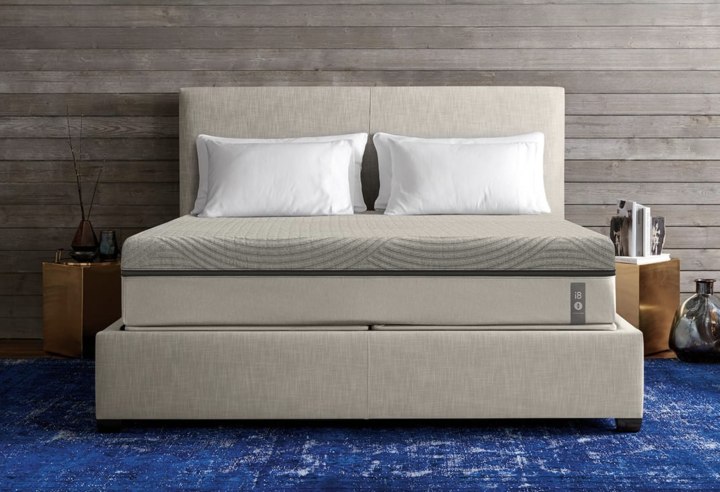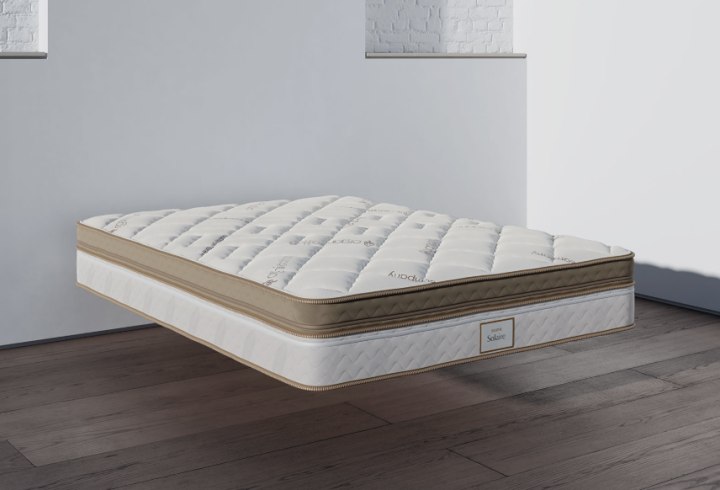Smart bed temperatures
Smart mattresses are embedded with technology that tracks how you sleep to fine-tune two factors that contribute to the quality of your slumber: mattress firmness and the temperature you find most comfortable for sleep. They can be controlled via apps that show statistics, often including an overall “sleep score.” For Seema Khosla, MD, medical director of the North Dakota Center for Sleep and chair of the American Academy of Sleep Medicine Technology Committee, variable temperature control is a particularly interesting feature. “The quicker your temperature drops, the faster you fall asleep,” she says. “That’s why the recommendation is a warm bath and a cool bedroom. If your bed can do that for you, that would be very helpful.”
Sleep tracking can be useful for people to become more conscious of how they’re sleeping, but they should resist getting mired in specific data as it may not be clinically validated. “If you can take action to improve sleep based on the data — like recognizing you need to sleep longer — then that’s helpful,” Khosla says.
Smart bed support levels
Like with any mattress, the most essential criterion for a smart bed is whether it delivers the support you need for spinal alignment, says Bert Jacobson, head of the School of Kinesiology, Applied Health and Recreation at Oklahoma State University, who researches the impact of sleep surfaces on slumber quality.
Your body type can determine what level of fitness is necessary for a good night's sleep. Heavier people tend to require firmer mattresses to support their body’s pressure zones, for example. “One size does not fit all. For the best support, a bed should conform to your weight and form, with different amounts of density where the body is heavier or lighter,” says Jacobson. A Consumer Reports survey found people with neck and back pain reported better sleep on adjustable air beds such as Sleep Number mattresses, where firmness could be precisely tweaked.
Smart bed customizations
That’s where a smart bed can tip the scales from a decent rest to the perfect slumber. Many smart beds whose firmness can be customized rely on adjustable air chambers that inflate or deflate automatically based on sensors that detect a sleeper’s shifting pressure distribution. The technology is helpful if you tend to switch positions in the night — the mattress can reshape itself to maintain support. “Side sleepers need a mattress to conform more to shoulders and hips, whereas a stomach or back sleeper has their body weight more evenly distributed,” explains Bill Fish, sleep science coach and managing editor of SleepFoundation.org.
Some queen-size and other, larger smart beds sport dual zones that customize for two sleepers. “This is great for couples with different sleep preferences,” says Fish. A pregnant woman, for example, may find customization useful for adjusting mattress support as their body changes. Fish adds that athletes may find this feature beneficial because they may want different firmness levels throughout a training cycle.
It’s worth thinking about whether you really want smart features like app control and automatic support changes. An adjustable air mattress like the Saatva Solaire, with fifty firmness settings per side operated by remote control, could be a good option for a couple with differing mattress needs, says Fish. With smart beds, there’s also the possibility of malfunction. “It’s important to note that when dealing with technology, you have to worry about one more thing to service,” he says. Many of these mattresses come with a three-month free trial, however, giving you ample nights for testing new sleep habits.
Now that you have a better understanding of the capabilities smart beds have to offer, here are five options to consider investing in for a comfortable night’s sleep.
Best smart beds of 2020
Best smart bed for hot sleepers: Eight Sleep
Eight Sleep Pod
Whether or not you’re prone to night sweats, the Eight Sleep Pod can usher in a more comfortable sleep thanks to automatic cooling or warming to ideal temperatures, as low as 55 degrees Fahrenheit and up to 110 degrees Fahrenheit. Within the mattress’s four-layer memory foam, sensors track heart and breathing rates plus sleep stages. This data syncs with the water-powered thermal engine to adjust mattress temperature throughout the night, with separate controls customizing each side of the bed. The Pod works with Amazon and Google home hubs to ask the mattress to warm up before bedtime. And if you find phone alarms jarring, you can also set the Pod to warm or cool to rouse you silently. An app displays each night’s sleep score, with recommendations for improvements.
Best smart bed for couples: Sleep Number
Sleep Number 360 i8
If you bunk with a partner whose sleep preferences differ, the dual-zoned 360 i8 can cater to both. Beneath a six-inch foam comfort layer, each side of the mattress has an air chamber that contours to body pressure throughout the night, according to each sleeper’s preferred firmness (or “Sleep Number”, which can range from 0-100 but tends to be within 35-50). The bed pairs with an adjustable base (from $1,119), allowing for manual raising of the mattress head or foot to relieve pressure or potentially stop a partner from snoring. It can also share data with smart devices, including activity trackers and the Nest Learning Thermostat, with an app showing how each person’s sleep quality correlates with factors like room temperature or fitness routine.
Best affordable smart bed: Sleep Number 360 c2
Sleep Number 360 c2
Compared to other Sleep Number mattresses, the 360 c2 offers the same customizability yet costs about one-third of the price. It has two air chambers with dual-zone sensors tracking heart rate, breathing rate and body pressure, automatically contouring each zone according to the sleeper’s ideal firmness. The app similarly tracks sleep quality and how it may correlate with other factors, including mattress firmness. The main difference between the c2 and costlier models: the comfort layer is noticeably slimmer at just two-inches thick.
Best smart bed for adjustability: Saatva
Saatva Solaire
The six-layer smart mattress from Saatva gives you 50 options for firmness, a remote to control them and air chambers designed to operate quietly. A hidden pump handles the work and a water-resistant structure will help keep the machinery running for years. On top of that, the smart bed is built using Saatva’s organic cotton, Talalay latex and gel-infused memory foam. The mattress is also finished with a cushioned pillow top — and its multi-directional air chambers are designed to provide even support for the sleeper. The bed itself is also sports and antimicrobial finish. You can trial the bed for 120 nights and return it during that time for your money back.
Best smart bed for support: ReSt Bed
If you work out a lot or have chronic pain, this ultra-customizable bed could be the ideal cocoon for joint aches and tired muscles. Its support can be finely calibrated thanks to five air chambers on each side for the legs, hips, lumbar, shoulders and head regions. Beneath two layers of gel memory foam, a medical-grade sensor grid continually detects a sleeper’s pressure distribution over 2000 data points, automatically adjusting firmness to maintain support. For extra pressure beneath painful areas, you can manually adjust support via the app, which also displays your sleep stats. The mattress is made with modular construction, meaning if one layer malfunctions, it can be fixed without the entire bed needing to be replaced.
More shopping guides and recommendations
"smart" - Google News
August 07, 2020 at 12:02AM
https://ift.tt/2PyDPB2
The best smart beds of 2020, according to sleep experts - NBC News
"smart" - Google News
https://ift.tt/2P2kUhG
https://ift.tt/3febf3M
Bagikan Berita Ini




















0 Response to "The best smart beds of 2020, according to sleep experts - NBC News"
Post a Comment